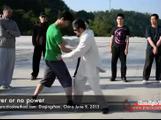The Master once said, “Everybody in the world uses momentum-based movement, therefore we do not. Taiji involves ‘contained spiral force’ that generates momentum on something external to oneself.”
Commentary:
Imagine a car is on a lift. The car is on, it has been put into drive, and someone is inside pushing the gas pedal to the floor. The tires are spinning rapidly on the axle. Now imagine touching one of the spinning tires. Ouch! Now imagine the same scenario, yet the tire pops off the axle and rolls away, carried by its forward momentum, for thirty or forty feet to where you happen to be standing. Now imagine bending down and touching it as it approaches. It slows to a stop and impotently topples over onto its side. In the first instance, the rotation is tightly contained, powerful and controlled. In the second instance the rotation becomes decreasingly powerful and cannot be controlled once it has been seperated from the axle.
It’s not that momentum-based attacks are ineffective, it’s just that the strong can always overcome the weak when both parties use momentum to fight. Yet, by mastering “contained spiral force” the “weak” can overcome the “strong.” Master Hong could not lift heavy rocks, yet could send strapping youths sailing through the air. You must become a gearbox with machine-like precision.



{ 4 comments… read them below or add one }
the torso as a torsion bar…. the segments of arms and legs like torsion springs…..the torso if trained properly is capable of being incredibly strong…. the spine allows the torso incredible flexibility…but if we negate the spines flexability and hold this as a last resort…attempting to maintain our alignments of shoulders directly over hips….the torso acts like a torsion bar… imagine you are a tree with roots deep in the ground and healthy limbs… an outside force on either side of your trunk is attatched very close to the trunk (to minimize the flexing of the limbs themselves) and force is exerted in opposite directions twisting the trunk..lets say your a pine tree (much more flexible than say oak)….. your trunk will begin to twist slightly under that pressure…becoming progressivly resistant as more force is applied an incredible amount of force in terms of potential energy is built up waiting to be released…much like torsion bar suspension used on tanks in ww2… the trunk can absorb and “contain” a lot of energy… if only as a tree you could “turn the joint to create opportunity”, as we can quickly as humans, all that potential energy can be redirected back towards the forces applied to it…….tendons are very strong and can be made to be flexible…by twisting them around the bones of their particular bone segments they develop a natural “elasticity strength” similar to the way a torsion spring works.. as force is exerted at either end and the tendon wraps around the bone, potential energy is stored much like the torsion bar, but in spring form…imagine twisting several of those elastic bands you guys train with around a spear(lubricating them to reduce friction as they are in the human anatomy) until it was under tremendous pressure…yikes.. if each limb segment is viewed as an induvidual spring, combined with the incredible energy capable of being stored in the torsion bar…think of the almost incomprehensible amount of destructive force that can be unleashed…none of which was generated by the practitioner themself..only skillful and accurate containment of applied force from the enemy…. it’s a good thing that master chen has an obvious and deep comprehension of martial ethics….and taiji has a natural tendency to make people balanced and kind hearted. it’s a beautiful thing you all are participating in…..
regarding “turning of the joints,” i like to use the image of a handful of marbles or ball bearings. if you squeeze, i mean really close your hand, that is full of marbles or ball bearings, they tend to be “squeezed” outwards. and this is a general principal that i use/train to deal with contrasting force. and directing the “squeeze” brings about the twisting you are talking about. at least if i am understanding your article in the proper light.
齿轮是紧密咬合在一起的,练拳中的松和紧应都是咬合的。我想是这样吧,很形象的比喻
齒輪箱是很好的聯想,說明合勁的意義。但實際上我們身上沒有齒輪,是骨架中的槓桿起作用, 一支槓桿撐着另一支槓桿(每個關節可算一個槓桿), 由支撑點撐到發力點, 如果中途沒撐到就是斷勁, 用慣性力則是沒有支撐的力的。